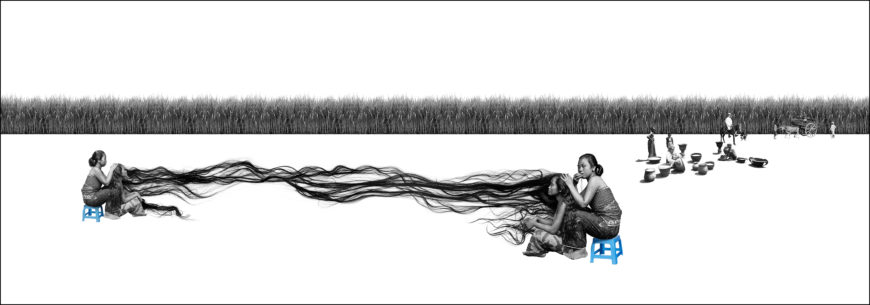
Yee I-Lann, Picturing Power #6: Wherein one cultivates cultural codes, the noble endeavors of mankind and thereby puts them in their place, 2013, Giclée print on cotton rag paper, 25 x 71 inches (courtesy of the artist)
Picturing Power #6 by Yee I-Lann presents two prominent horizontal elements. Above, a row of sugarcane spans the width of the picture as an almost perfect line. Below, the undulating hair of a Javanese woman stretches across a white field. Accompanying this woman is another who delouses her scalp while sitting on a light blue plastic stool—the only color in an otherwise black-and-white image. This woman looks up at the camera with a sharp, penetrating gaze. This pair appears again, reversed, on left side of the image. Their scale and placement locates the pair on the left in the middle ground, while the pair on the right is set in the foreground. Potters can be seen in the distance, and beyond them, a figure stands before a cart laden with harvested sugarcane while another squats nearby. These figures are flanked by the two men in white suits, overseers who recall the enforcement of the coercive labor practices used against local people when Java was under Dutch control.
Picturing Power #6 is part of a digital photomontage series made with images sourced from a Dutch colonial archive. This collection, currently housed at the Tropenmuseum of Amsterdam, offers visual documentation of the nearly 400-year-long history of colonialism in the Dutch East Indies (now Indonesia), Dutch Formosa (now Taiwan), and Ceylon (now Sri Lanka). In Yee’s photomontage series, these black-and-white archival images are digitally stripped of their backgrounds and recontextualized. Yee’s Picturing Power #6—and the series as a whole—narrates how the histories of colonialism in Southeast Asia reverberate to the present moment. At the same time, Yee’s arrangement of the images challenge the original intent of the archival source material, turning it into one of refusal and recovery.
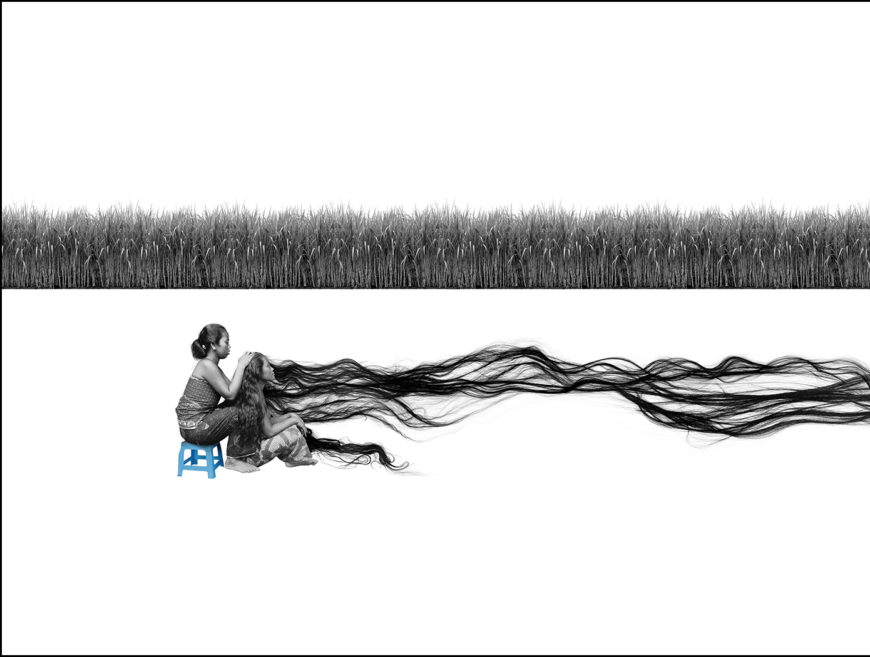
Yee I-Lann, detail with left half of Picturing Power #6: Wherein one cultivates cultural codes, the noble endeavors of mankind and thereby puts them in their place, 2013, Giclée print on cotton rag paper, 25 x 71 inches (courtesy of the artist)
Bringing historical archives to the present
The horizontal axis of sugarcane is formed from the multiplication of a single image that repeats over and over, creating a visual barrier at the horizon. The artist’s decision to multiply the same image is not unlike the method of monocultural farming, a dominant mode of colonial agricultural production in the regions spanning present-day Malaysia, Indonesia, and the Philippines. Monocultural farming replaced crop variety with a single variant. As a result, a biodiverse indigenous agriculture was replaced by a system of large plantations that maximized the yield of cash crops for the global market.
Sugarcane was one of these cash crops. The Dutch oversaw sugar production in Java in the 17th century, and by 19th century the Dutch colony was one of the world’s leading producers of sugar. This very lucrative colonial trade depleted the soil and required the work of an enormous number of laborers. Yee’s linear arrangement of the same archival image of sugarcane references the serialized, industrial landscapes created by monocrop plantation—while also implying their persistence beyond the colonial era.
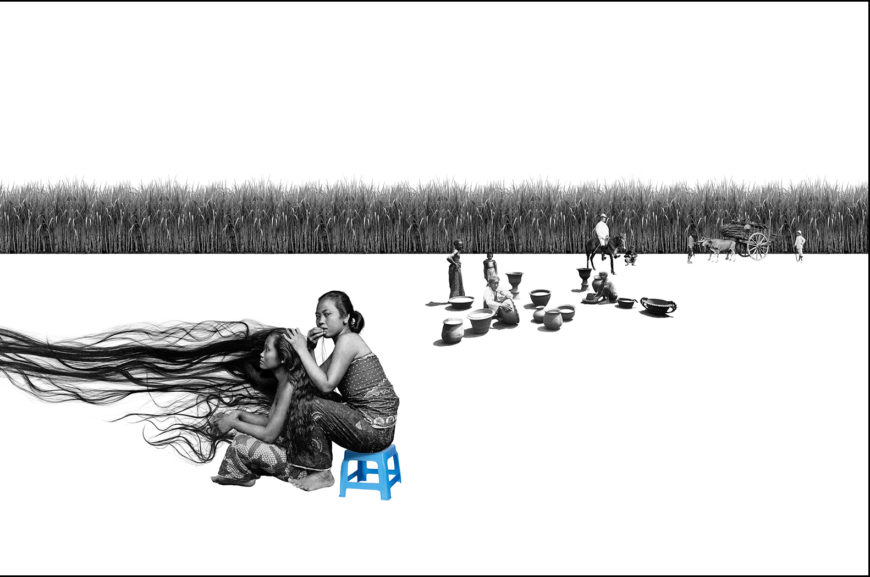
Yee I-Lann, right half of Picturing Power #6: Wherein one cultivates cultural codes, the noble endeavors of mankind and thereby puts them in their place, 2013, Giclée print on cotton rag paper, 25 x 71 inches (courtesy of the artist)
With sugarcane as a backdrop, the images of Javanese people and colonial administrators are stitched together to form an orthogonal line that moves from the lower left to the upper right and evokes one-point linear perspective. The perspective draws our attention to the women seated in foreground and their doubles in the middle ground. One sitter delouses the other. The synthetic hue of the stool upon which she sits (and which replaced a wood block in the original photograph) implies that these figures no longer belong solely to the 19th century. These women exist in the past and in the present, a result of the artist’s digital intervention. They are set against a jarring whiteness, and the almost impossibly long stands of hair that bind together the two pairs of women adds a supernatural element to the image.
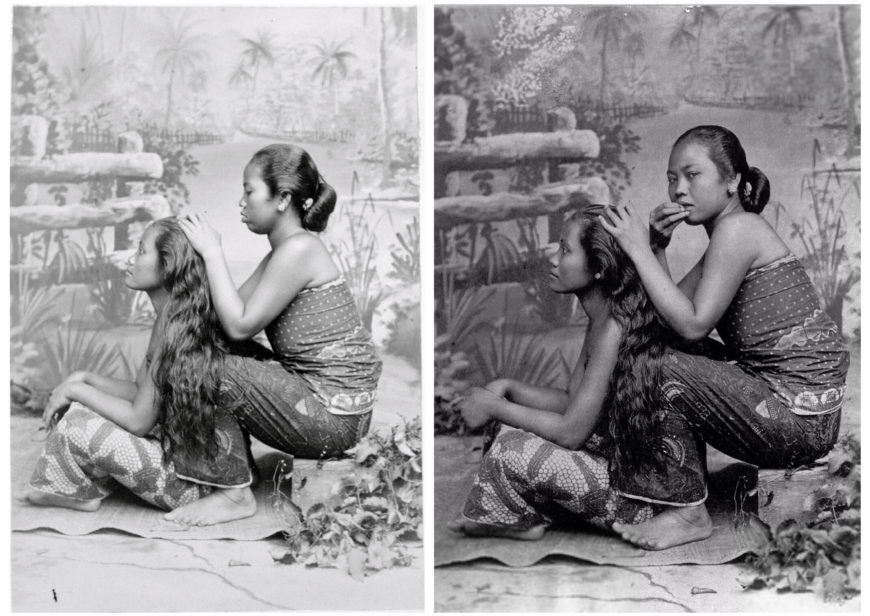
Studio Portrait of two women delousing, c. 1870–92, paper, 5.5 x 3.75 inches (Tropenmuseum Amsterdam)
Enacting refusal of the colonial archive
The original archival photos were taken in a photography studio against a painted backdrop depicting a landscape with palm trees. The sitter would likely have posed in front of a large camera while following the photographer’s instructions to enact delousing, holding still during the extended exposure of the photographic plate. The photo itself exposes the anthropological guise of the project as a social scientific study of indigenous people and their livelihoods. This is readily apparent when similar photographs in the Tropenmuseum archive are compared. In nearly identical compositions, the sitters gaze remains contained within the vignette. This act of delousing is reproduced over and over in the archive, having been circulated as postcards, souvenirs, and photo albums, and so forming a colonial narrative of Javanese women as “primitive.”
Colonial photographs such as these highlight the stark division between who observes whom, and this hierarchy is reinforced by racialized and sexualized tropes such as the enactment of delousing. The artist’s choice to work with these particular images was part of her effort to challenge the narrative of disempowered colonized women. By focusing on one woman’s split second refusal to passively accept the colonizer’s gaze—to glance back—the artist could reverse the asymmetry of colonial power documented in these photographs.
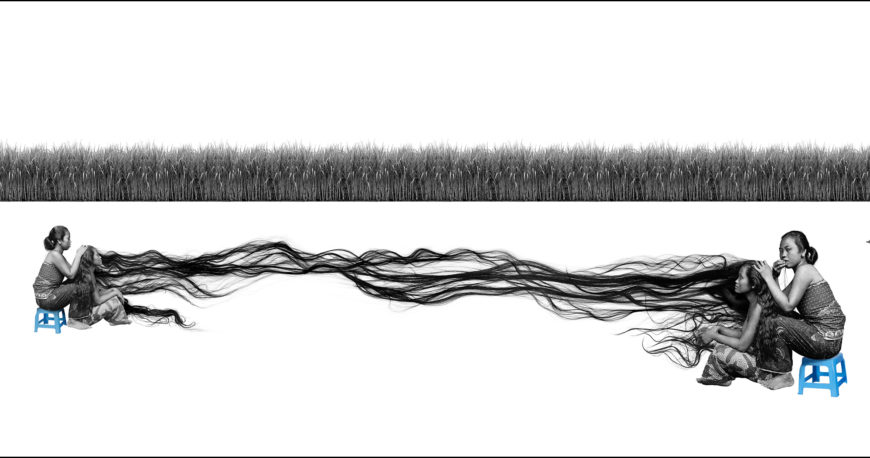
Yee I-Lann, Picturing Power #6: Wherein one cultivates cultural codes, the noble endeavors of mankind and thereby puts them in their place (detail), 2013, Giclée print on cotton rag paper, 25 x 71 inches (courtesy of the artist)
Through the careful selection and reorganization of archival images, the artist disrupts the colonial-era narrative and reorients who is doing the seeing and who is being seen. While this strategy is visible in Yee’s earlier work (Horizon series (2003) and Sulu Stories (2005) are examples), Picturing Power #6 is perhaps her most explicit effort to counter these damaging narratives. Yee recognized the importance of a rare photo that documents one of the women looking up directly at the camera. The woman’s discomfort at being photographed is evident, but in this moment she further refuses the role of passive object by choosing to look back at us.
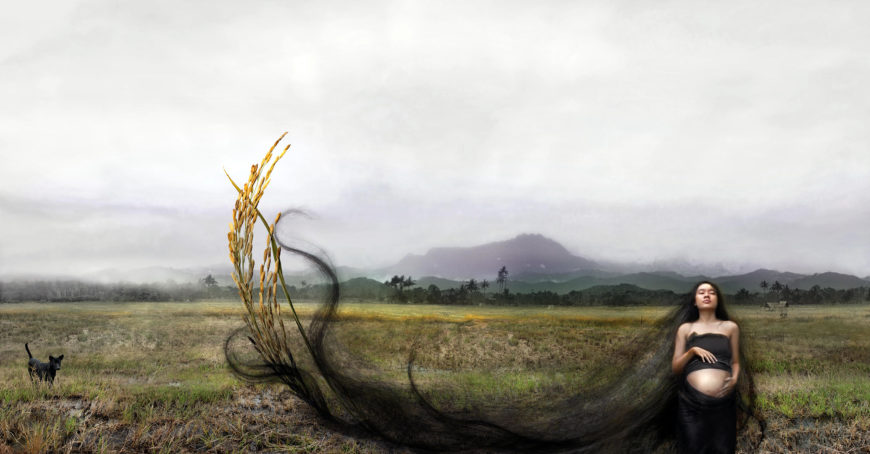
Yee I-Lann, Kinabalu Series: Huminodun, 2007, color digital print, 105 x 204 cm (courtesy of the artist)
As we have seen, Yee’s intervention goes beyond thoughtful archival selection. By digitally mirroring images of the two women, self encounters self, connected by hair so long that it becomes an abstraction. Yee featured similarly long hair in earlier work that depicts the goddess Huminodun. Given this subject, we can read the two women in Picturing Power #6 as two mythological beings. Like Huminodun, they might heal the earth that has been ravaged and depleted by sugarcane.
In a visual field defined by the colonial practices of global capitalism, sugarcane monoculture, and the disempowerment of indigenous women, Picturing Power #6 presents a goddess who gazes back at the camera and the viewer. Yee’s formulations lay bare the prejudices of the archive, infiltrating and destabilizing it while attesting to the possibility of resistance, even if only through a momentary glance. Her work allows the photographed object to become narrators of their own stories.


